Ch. 12 MENDEL’S EXPERIMENTS AND HEREDITY
1/60
There's no tags or description
Looks like no tags are added yet.
Name | Mastery | Learn | Test | Matching | Spaced |
|---|
No study sessions yet.
61 Terms
Gregor Johann Mendel
Considered the father of genetics
He studied pea plants to discover how traits are passed from parents to offspring.
Mendel used mathematical analysis to find predictable patterns in inheritance
Genetics
study of heredity and inherited traits
-how traits (like eye color, hair type, or height) are passed from parents to their offspring through genes .
Genes
functional hereditary units on chromosomes
they are passed from parents to offspring during reproduction.
Locus
specific location or position of a gene on a chromosome.
Alleles
versions of a gene
different versions of the same gene that are found at the same locus (location) on a pair of chromosomes.
You inherit one allele from each parent — one from the egg and one from the sperm.
Together, the two alleles determine your genotype and phenotype for that trait.
Alleles can be:
Dominant (capital letter) – the trait that shows up (example: A)
Recessive (lowercase letter) – the trait that’s hidden when a dominant allele is present (example: a)
Examples:
In Mendel’s pea plants:
The gene for flower color has two alleles:
P = purple (dominant)
p = white (recessive)
Possible combinations:
PP → purple
Pp → purple
pp → white
In humans:
The gene for earlobe shape has two alleles: free (E) and attached (e).
Model System
species or biological system used to study a specific biological phenomenon to be applied to other different species
Blending Theory Of Inheritance
hypothetical inheritance pattern in which parental traits are blended together in the offspring to produce an intermediate physical appearance
Continuous Variation
inheritance pattern in which a character shows a range of trait values with small gradations rather than large gaps between them
Discontinuous Variation
inheritance pattern in which traits are distinct and are transmitted independently of one another
Hybridization
process of mating two individuals that differ with the goal of achieving a certain characteristic in their offspring
P0
used in first-generation crossed
parent generation of true breeding plants
F1
first filial generation of offspring from a cross between parents
(brothers and sisters)
F2
second filial generation of offspring produce by crossing 2 f1 individuals with each other
f3 , f4, f5
Succeeding generations
Cross sibs
mating between brothers and sisters
Backcross
mating an offspring back to a parent of other ancestor
Self cross
crossing a plant with itself (selfing)
True breeding
when parents having the same traits always produce offspring having the same traits
trait
variation in the physical appearance of a heritable characteristic
Formal Cross for One Trait
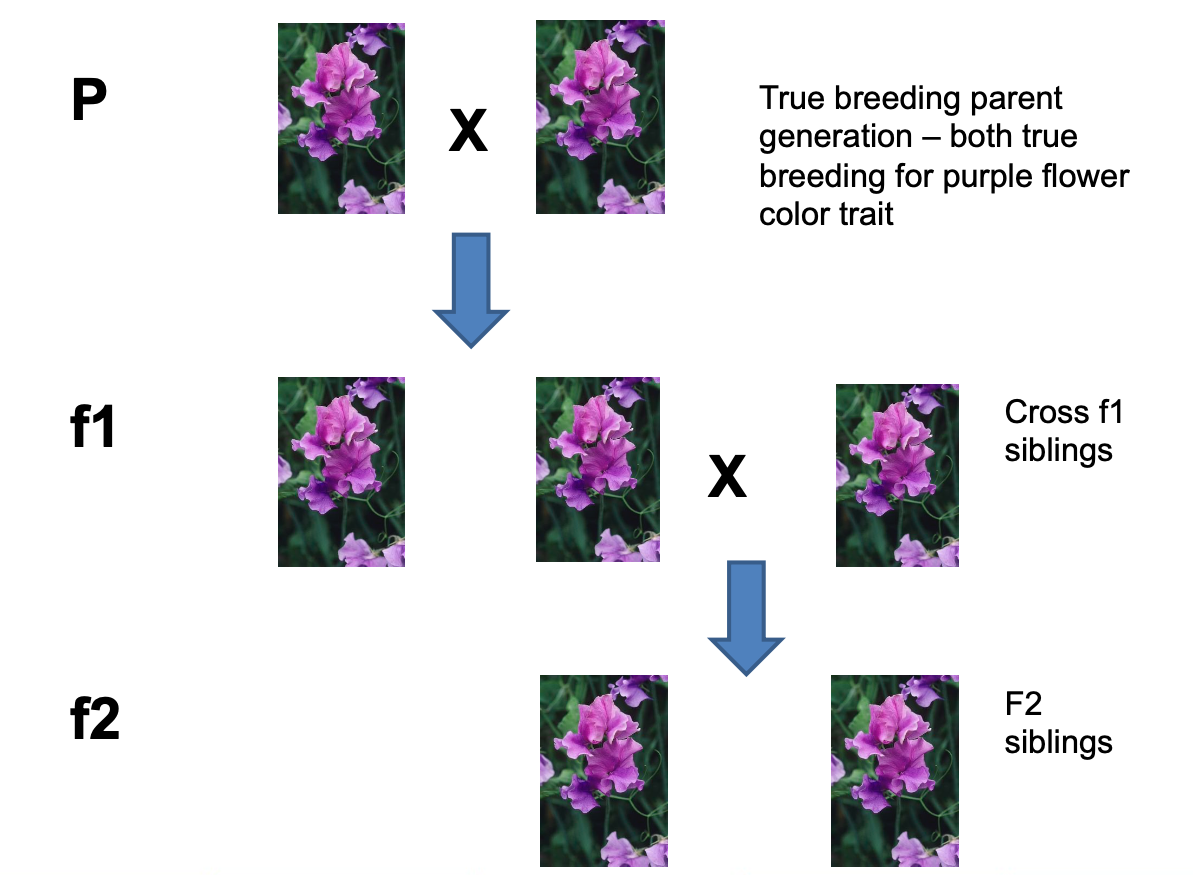
Formal monohybrid cross
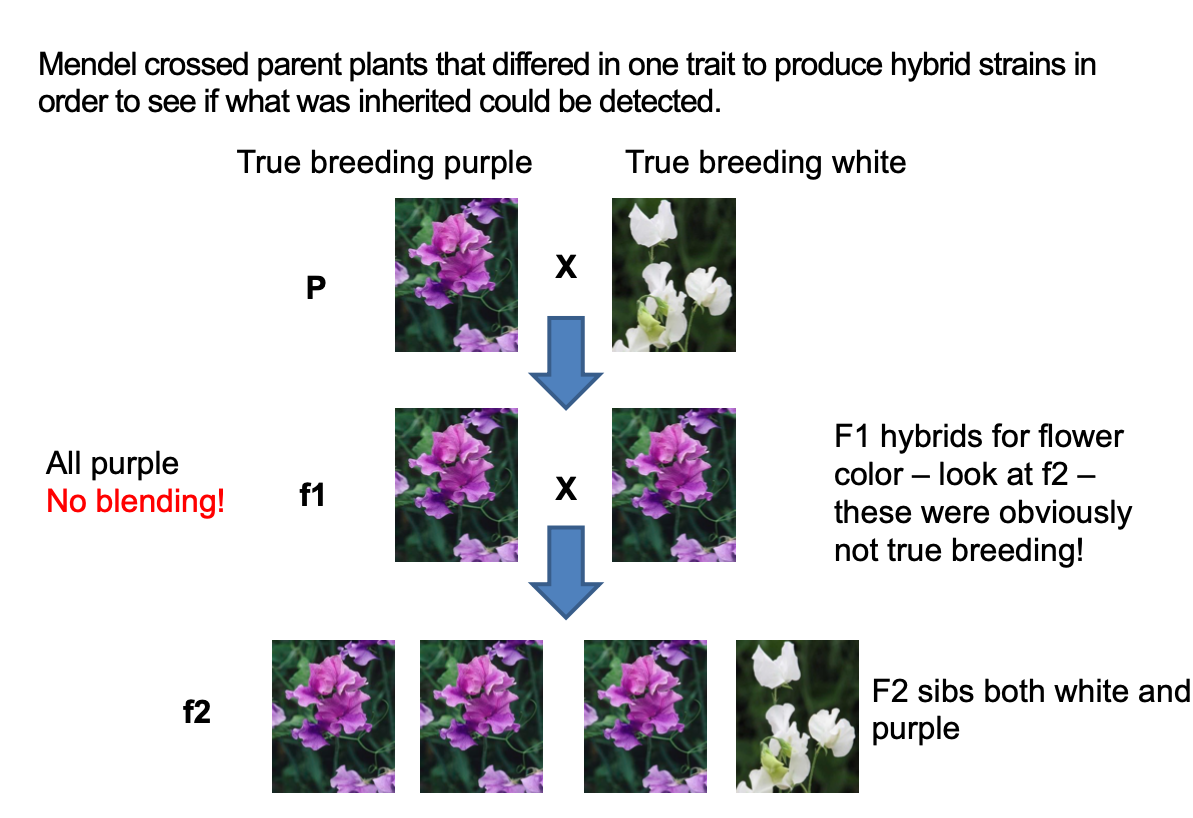
RESULTS FROM F2 TYPES
Background:
In one experiment, Mendel crossed plants that were true-breeding for violet flower color with plants true-breeding for white flower color (the P generation).
Results:
• F1 generation all had violet flowers.
• F2 generation, approximately three quarters of the plants had violet flowers, and one quarter had white flowers.
• 3:1 f2 ratio from a formal monohybrid cross held true for other monohybrid crosses with different traits
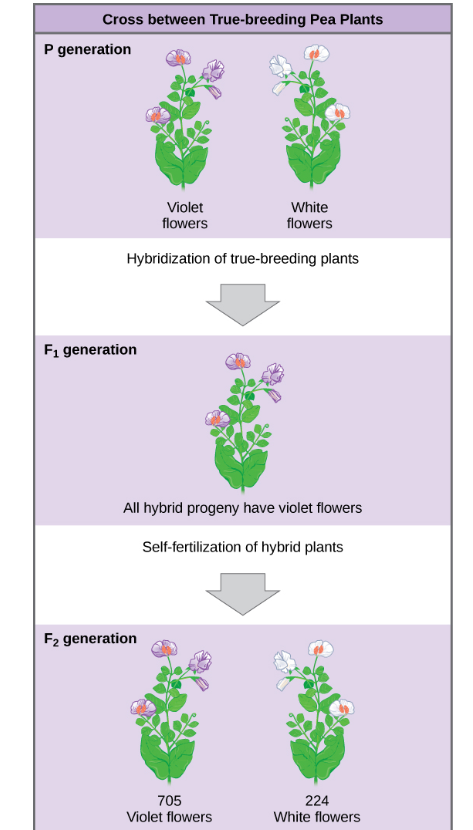
Dominant traits
a trait that appears or is expressed when at least one dominant allele for a gene is present.
written with capital letters
Recessive traits
trait that is hidden or not shown when a dominant allele is present
It only appears when an organism has two recessive alleles (one from each parent) — meaning no dominant allele is there to mask it .
recessive traits use lowercase
Phenotype
the characteristic version of a trait we actually see. What we can measure.
Example:
purple flower or blue eyes
Genotype
Underlying genetic makeup, includes both visible and non-expressed alleles
the set of alleles (gene versions) it has for a specific trait.
It determines what traits an organism can show, even if some traits are hidden by dominance .There are three main types of genotypes:
Homozygous dominant (AA)
Heterozygous (Aa)
Homozygous recessive (aa)
phenotype vs genotype
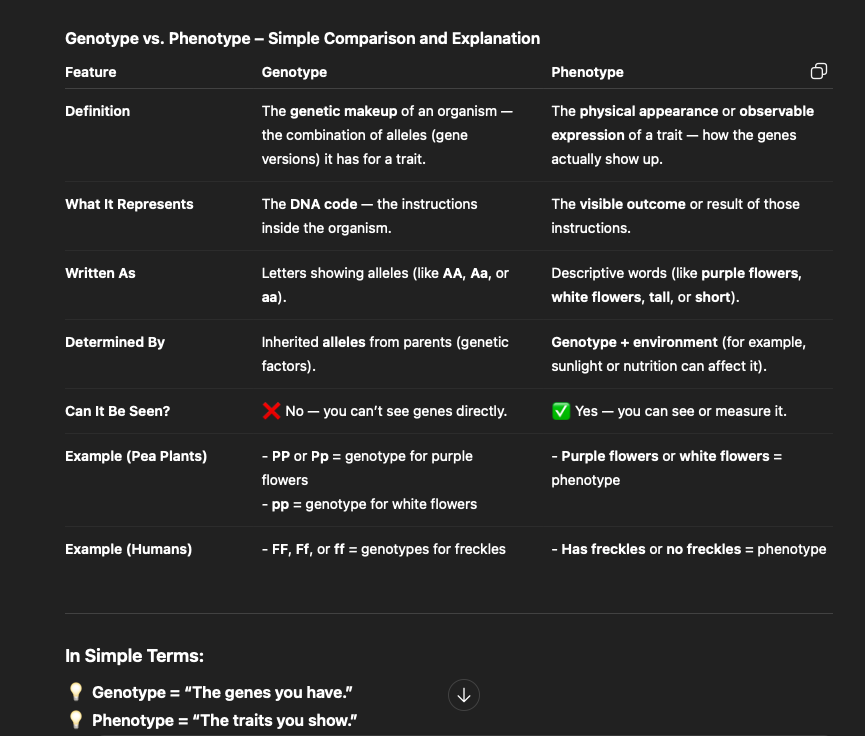
Homozygote
when both alleles for the same trait are the same.
Example: PP or pp (Note – homozygotes are always true breeding)
Homozygous dominant (AA)
(AA) – two dominant alleles.
Homozygous recessive (aa)
(aa) two recessive alleles.
Heterozygote
when alleles for the same trait differ. Example Pp (Note
– heterozygotes are always non-true breeding).
an organism that has two different alleles for the same gene — one dominant and one recessive.
Because the alleles are different, the dominant allele determines which trait is shown (the phenotype) .Examples:
In Mendel’s pea plants:
Pp → purple flowers (because purple is dominant over white).
Zygote
first diploid cell produced by fertilization
The zygote is diploid (2n) because it has two copies of each gene — one from the egg and one from the sperm.
It carries the genetic information that determines all of the offspring’s traits.
The zygote divides by mitosis to form an embryo, which eventually grows into a fully developed organism.
Examples:
In humans:
An egg (23 chromosomes) and a sperm (23 chromosomes) combine → zygote with 46 chromosomes
Reciprocal cross
type of genetic experiment where two crosses are made between the same traits, but the sex of the parents is switched.
It helps scientists find out whether a trait is linked to the sex of the parent or inherited equally from both parents .
Wildtype allele
the most common allele in a population (so called “normal allele”)
Mutant allele
changed or altered version of a gene that forms when the DNA sequence mutates (changes).
Monohybrid crosses
A cross between two individuals heterozygous for one allele.
Example (Mendel’s Pea Plants):
Trait: Seed color
Y = yellow (dominant)
y = green (recessive)
Parent genotypes: Yy × Yy
Y
y
Y
YY
Yy
y
Yy
yy
Results:
Genotype ratio: 1 YY : 2 Yy : 1 yy
Phenotype ratio: 3 yellow : 1 green
In Words:
75% of the offspring show the dominant trait (yellow).
25% show the recessive trait (green).
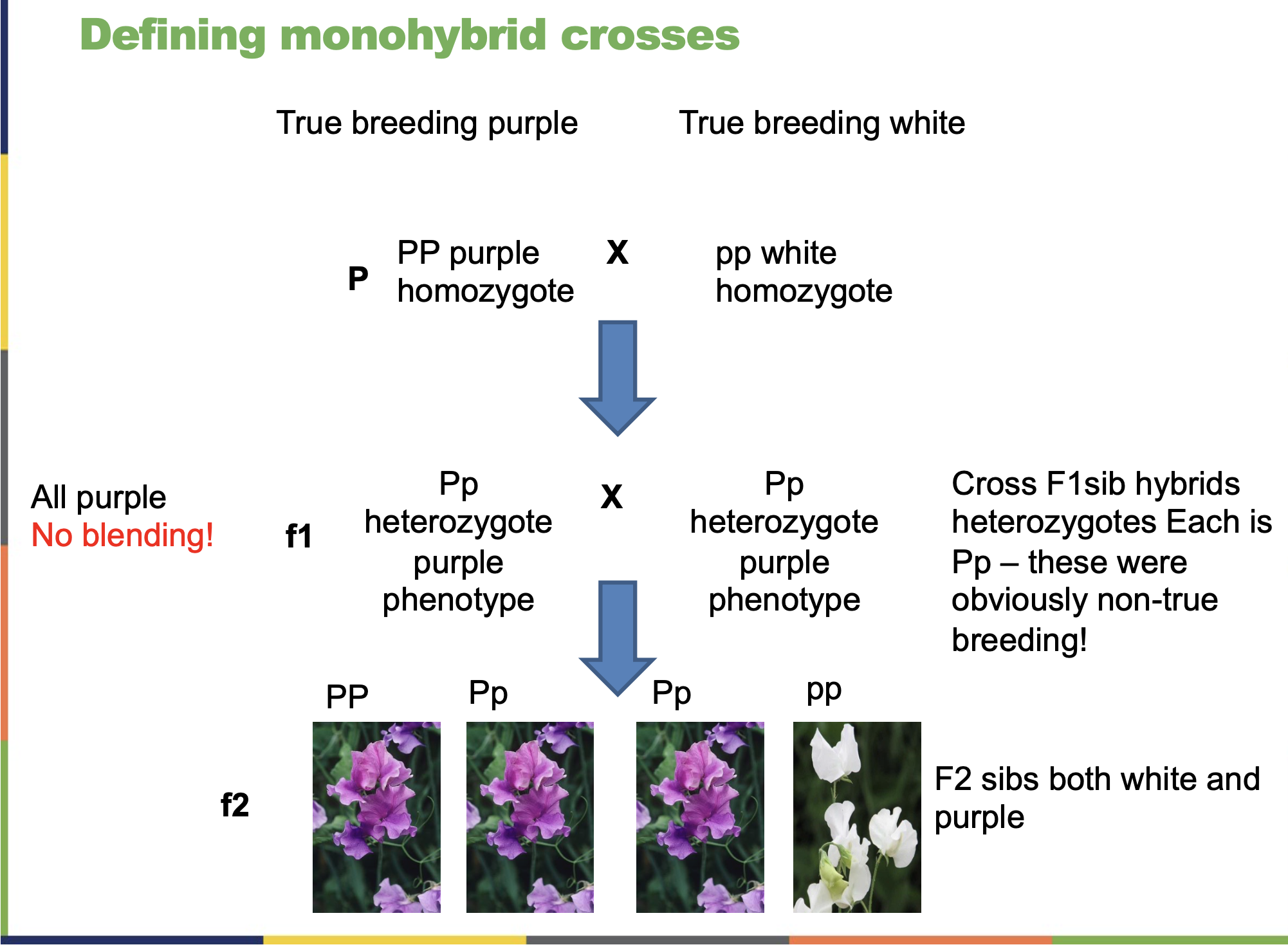
Mendel’s First Law
Each organism has two alleles for each trait.
These alleles separate (segregate) during gamete formation, so each gamete gets only one.
At fertilization, the alleles combine again.
If a parent has genotype Aa (one dominant, one recessive):
Half their gametes carry A,
Half carry a.
This follows Mendel’s Law of Segregation — the alleles separate during gamete formation.
formal test cross
genetic experiment used to determine the genotype of an individual that shows a dominant trait, but whose genetic makeup (alleles) is unknown.
It is done by crossing that individual with another that is homozygous recessive (shows the recessive trait) for the same gene .
helps identify whether the individual is homozygous dominant (AA) or heterozygous (Aa).
Because the recessive individual only contributes recessive alleles, the offspring’s traits will reveal whether the unknown parent carries one or two dominant alleles.
test cross
Determine whether an organism expressing a dominant trait is a homozygote or a heterozygote.
A test cross is a genetic experiment used to find out the genotype of an organism that shows a dominant trait.
It’s done by crossing that organism with another that is homozygous recessive (has two recessive alleles for the same trait) .Why It’s Used:
Sometimes, an organism looks like it has a dominant trait, but we can’t tell if it’s:
Homozygous dominant (AA) → has two dominant alleles, or
Heterozygous (Aa) → has one dominant and one recessive allele.
A test cross helps us figure that out by looking at the offspring’s traits.
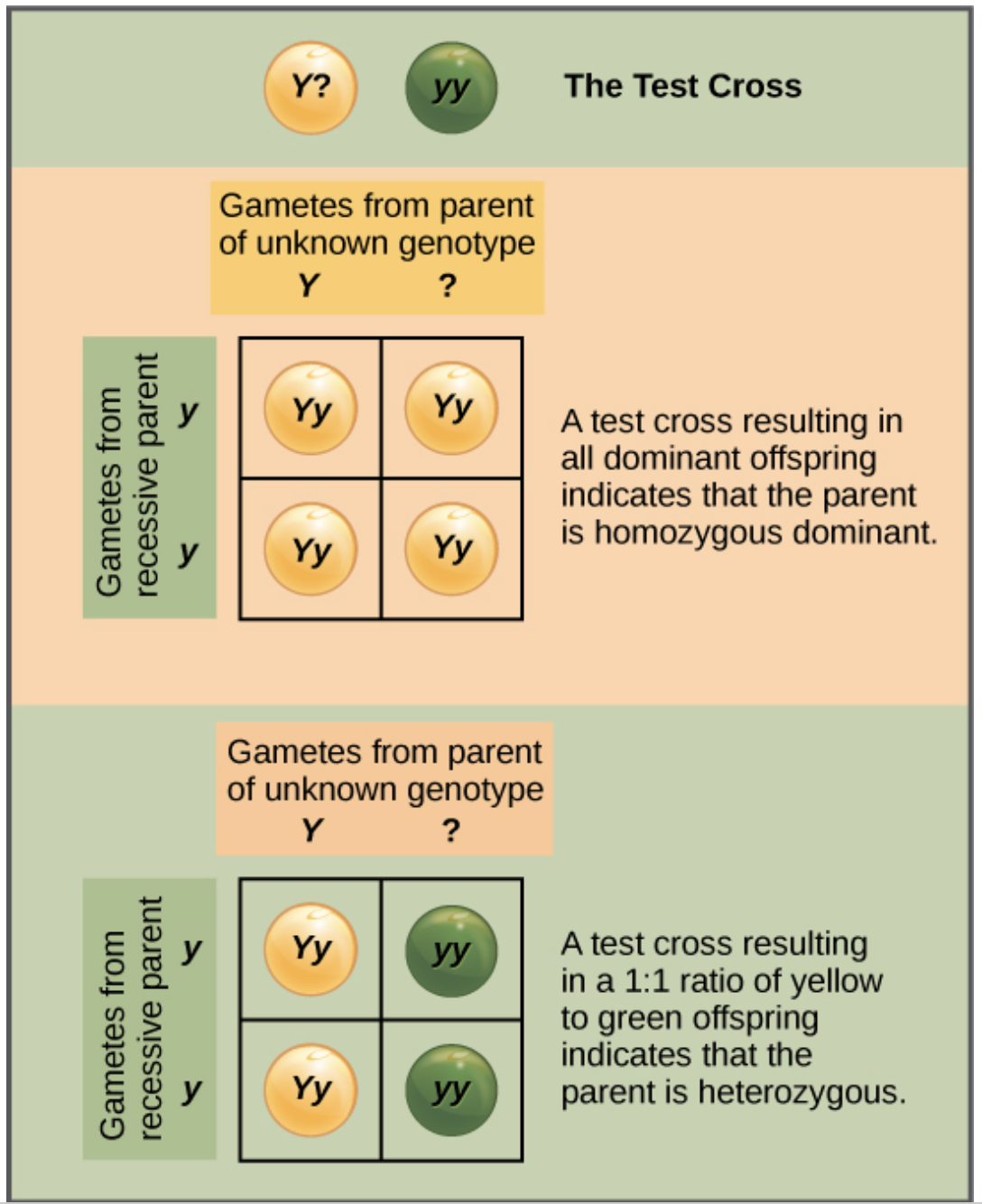
Punnet square
simple diagram used to predict the possible genetic outcomes (genotypes and phenotypes) of a cross between two parents.
It shows all the ways alleles from each parent can combine in their offspring .
Example (Mendel’s Pea Plants – Flower Color):
Parent 1 = Pp (purple)
Parent 2 = Pp (purple)
P | p | |
|---|---|---|
P | PP | Pp |
p | Pp | pp |
Results:
Genotypes: 1 PP, 2 Pp, 1 pp
Phenotypes:
3 purple (PP or Pp)
1 white (pp)
Ratio → 3:1
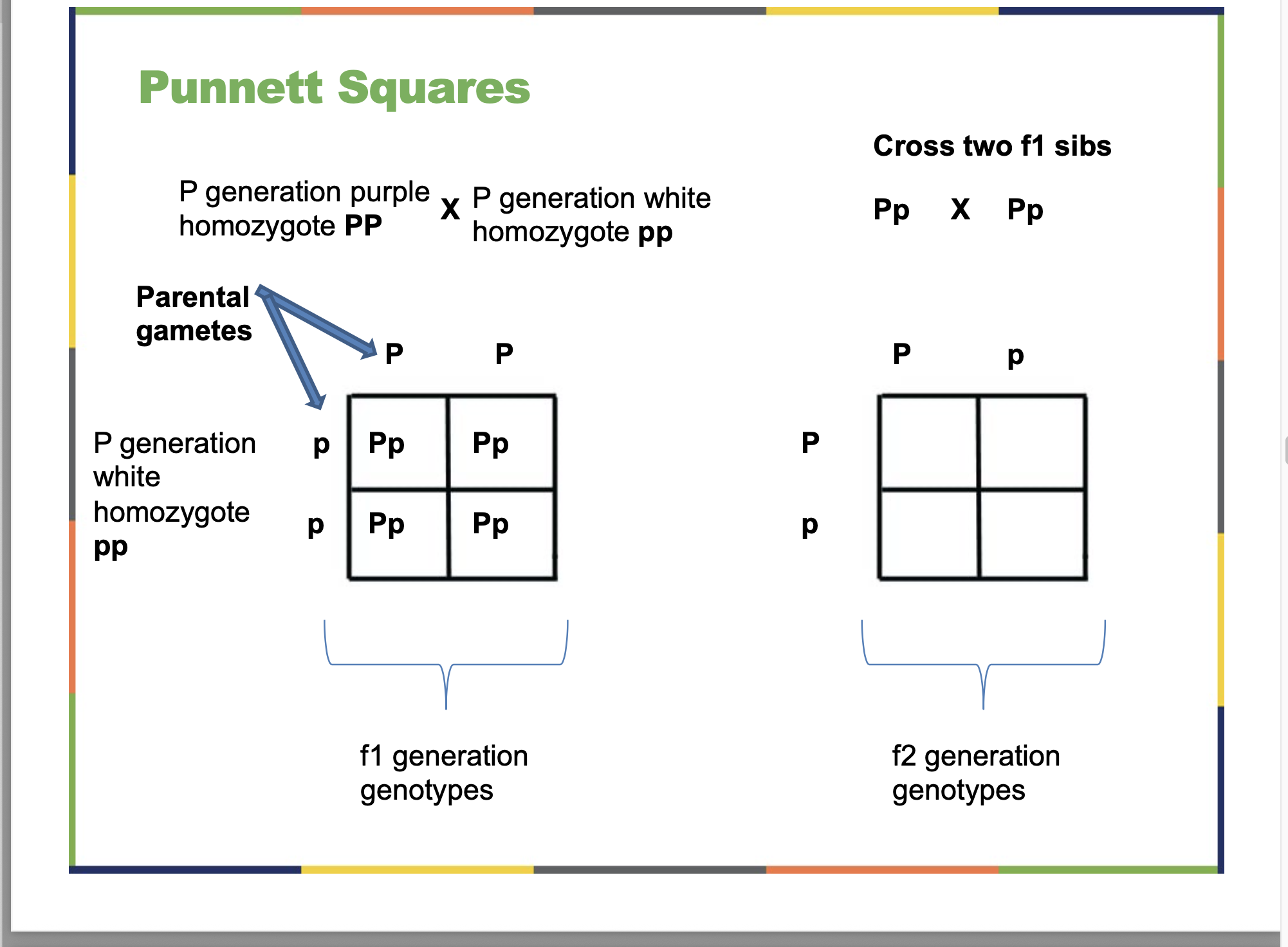
pedigree analysis
method used by geneticists to study how traits are passed down through several generations of a family.
uses a family tree diagram (pedigree chart) to track which members show a particular trait or genetic condition and to determine how that trait is inherited .
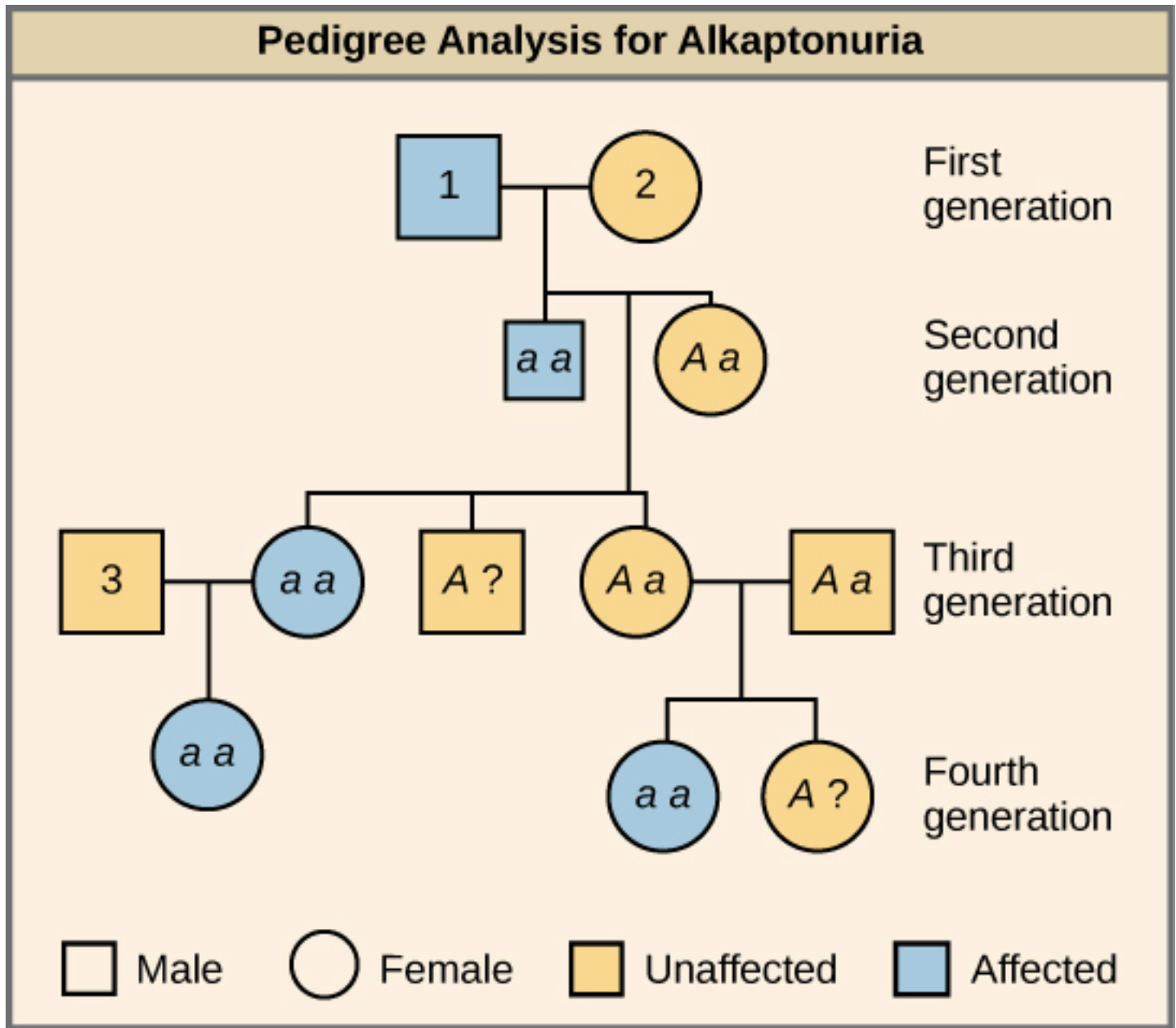
Symbols For Pedigrees

incomplete dominance
when neither allele is completely dominant over the other, so the offspring shows a blend or mix of the two parent traits.
The result is a new, intermediate phenotype that’s in between the parents’ traits .
Flower color in snapdragons:
Red (RR) × White (rr) → Pink (Rr)
The pink color is a blend of red and white — neither allele is fully dominant.
🐮 Coat color in cattle:
Red (RR) × White (rr) → Roan (Rr) (a mixture of red and white hairs).
🧬 Humans:
Incomplete dominance can occur in some traits, like hair texture:
Curly (CC) × Straight (cc) → Wavy (Cc).
codominance
in a heterozygote, complete and simultaneous expression of both alleles for the same characteristic
both alleles for a trait are expressed equally in the offspring — neither one is masked or blended.
(combination)
Examples:
🩸 Human Blood Type (AB):
Alleles: A and B are codominant.
If a person inherits A from one parent and B from the other → Blood Type AB.
Both A and B proteins appear on the red blood cells — neither hides the other.
🐮 Cattle Coat Color:
Red (RR) × White (WW) → Roan (RW), where both red and white hairs appear together (not pink).
🌺 Flowers:
A flower with codominant alleles for red (R) and white (W) petals produces red-and-white spotted petals (RW).
autosomes
any of the non-sex chromosomes
the chromosomes that carry genes for regular body traits like eye color, height, and blood type (not traits related to being male or female).
Humans have 22 pairs of autosomes, which are the same in both males and females .
Key Details:
Humans have 46 chromosomes in total, arranged in 23 pairs:
22 pairs are autosomes.
1 pair is the sex chromosomes (X and Y).
Autosomes contain genes that control most of the body’s growth, development, and functions.
Both men and women share the same set of autosomes, so traits on these chromosomes are inherited equally from both parents.
X-linked
genes that are located on the X chromosome, one of the two sex chromosomes (X and Y).
Traits or disorders controlled by X-linked genes are called X-linked traits or X-linked inheritance .
if a gene is X-linked, males have only one chance — one copy of that gene — so the trait or disorder shows up more easily.
Females (XX) have two X chromosomes, so they have two copies of each X-linked gene.
Males (XY) have only one X chromosome, so they have only one copy of each X-linked gene.
This means if a male inherits a recessive X-linked trait, it will show up, because there’s no second X to mask it.
X-linked traits are often recessive and appear more often in males than females.

Hemizygous
presence of only one allele for a characteristic, as in X-linkage; hemizygosity makes descriptions of dominance and recessiveness irrelevant
having only one copy of a gene instead of the usual pair.
In genetics, this term is most often used to describe males, who have one X chromosome and one Y chromosome — so they only have one allele for genes found on the X chromosome .
Explains why X-linked traits (like hemophilia or color blindness) are more common in males.
Males can’t be “carriers” for X-linked recessive traits — they either have it or don’t.
Examples:
In humans:
Males are hemizygous for genes on the X chromosome (like the gene for color vision or blood clotting).
If a male inherits a recessive X-linked allele (like the one for color blindness), he will show the trait, since there’s no matching allele on the Y chromosome to mask it.
Sex-Linked
any gene on a sex chromosome
trait that is controlled by a gene located on one of the sex chromosomes — either the X or Y chromosome.
If a gene is on the X or Y, it’s sex-linked — meaning the trait’s inheritance depends on the person’s sex (male or female).
Most sex-linked traits are X-linked, because the X chromosome is much larger and carries many more genes than the Y chromosome .
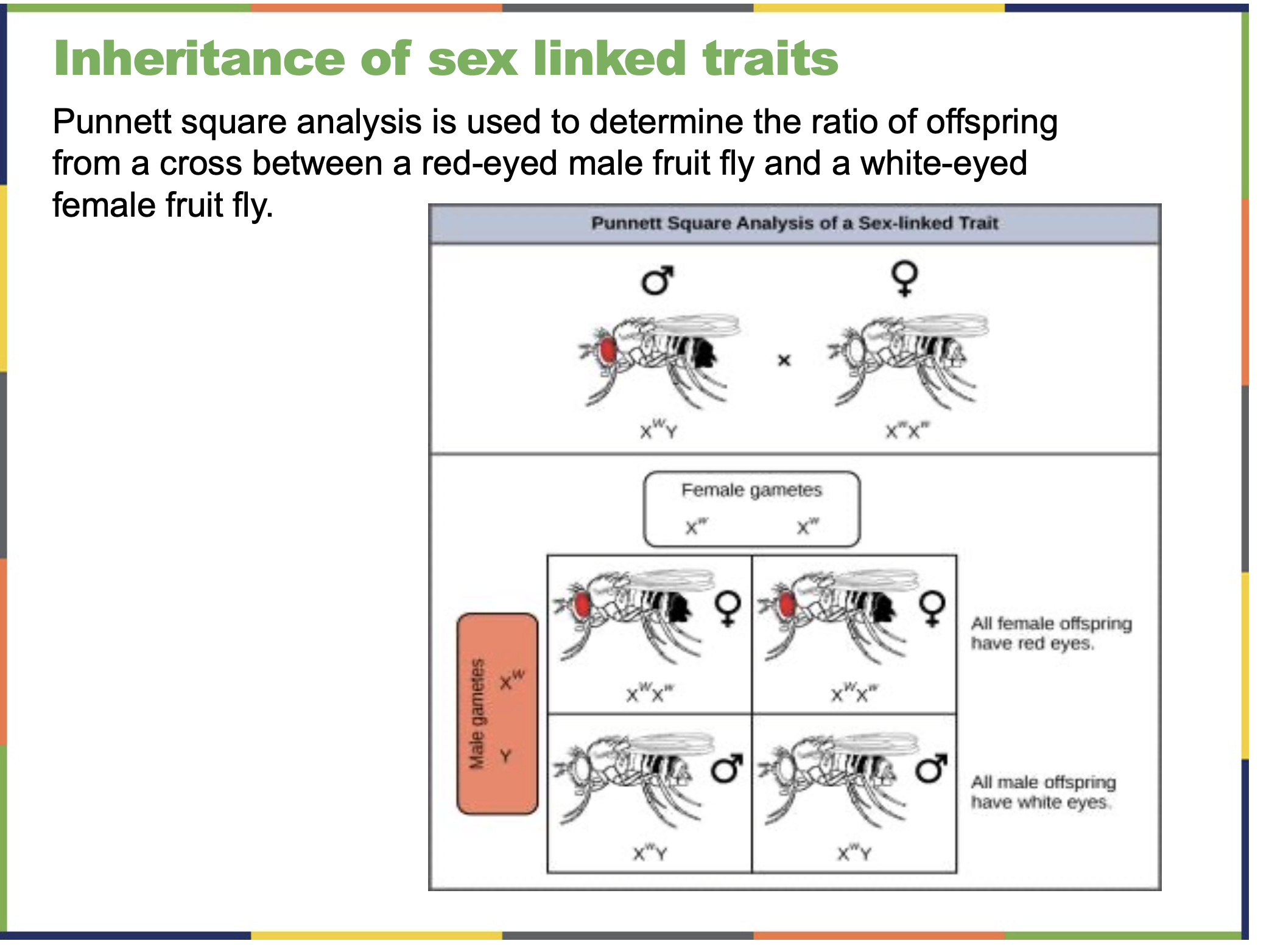
Recessive Lethal
inheritance pattern in which an allele is only lethal in the homozygous form and in which the heterozygote may be normal or have some altered non-lethal phenotype
inheritance pattern in which an allele is only lethal in the homozygous form and in which the heterozygote may be normal or have some altered non-lethal phenotype
dominant lethal
inheritance pattern in which an allele is lethal both in the homozygote and the heterozygote; this allele can only be transmitted if the lethality phenotype occurs after reproductive age
a gene version (allele) that causes death even if only one copy is present
Because it’s dominant, just one copy of the allele is enough to show its effect.
Since it’s lethal, the individual usually dies before reaching reproductive age, so these alleles don’t last long in populations.
However, some dominant lethal alleles can remain if the symptoms appear later in life, after reproduction.
🧠 Example:
Huntington’s disease in humans is caused by a dominant lethal allele.
It usually shows up in adulthood, after the person has already had children, so the allele can still be passed on.
Crossover
the process where homologous chromosomes exchange pieces of DNA during prophase I of meiosis.
This swapping of genetic material creates new combinations of genes, which increases genetic variation in offspring .
Happens between homologous chromosomes (a pair of chromosomes — one from the mother and one from the father — that carry the same genes).
Occurs during Prophase I of meiosis, when homologous chromosomes pair up and form a structure called a tetrad.
At points where the chromosomes touch and exchange segments, called chiasmata, genetic material is swapped.
After crossing over, the resulting chromosomes contain a mix of maternal and paternal genes.
Example (Simplified):
Imagine two homologous chromosomes:
One from the mother: ABCD
One from the father: abcd
After crossover, they might exchange parts like this:
New chromosome 1: ABcd
New chromosome 2: abCD
This creates new genetic combinations that were not present before!
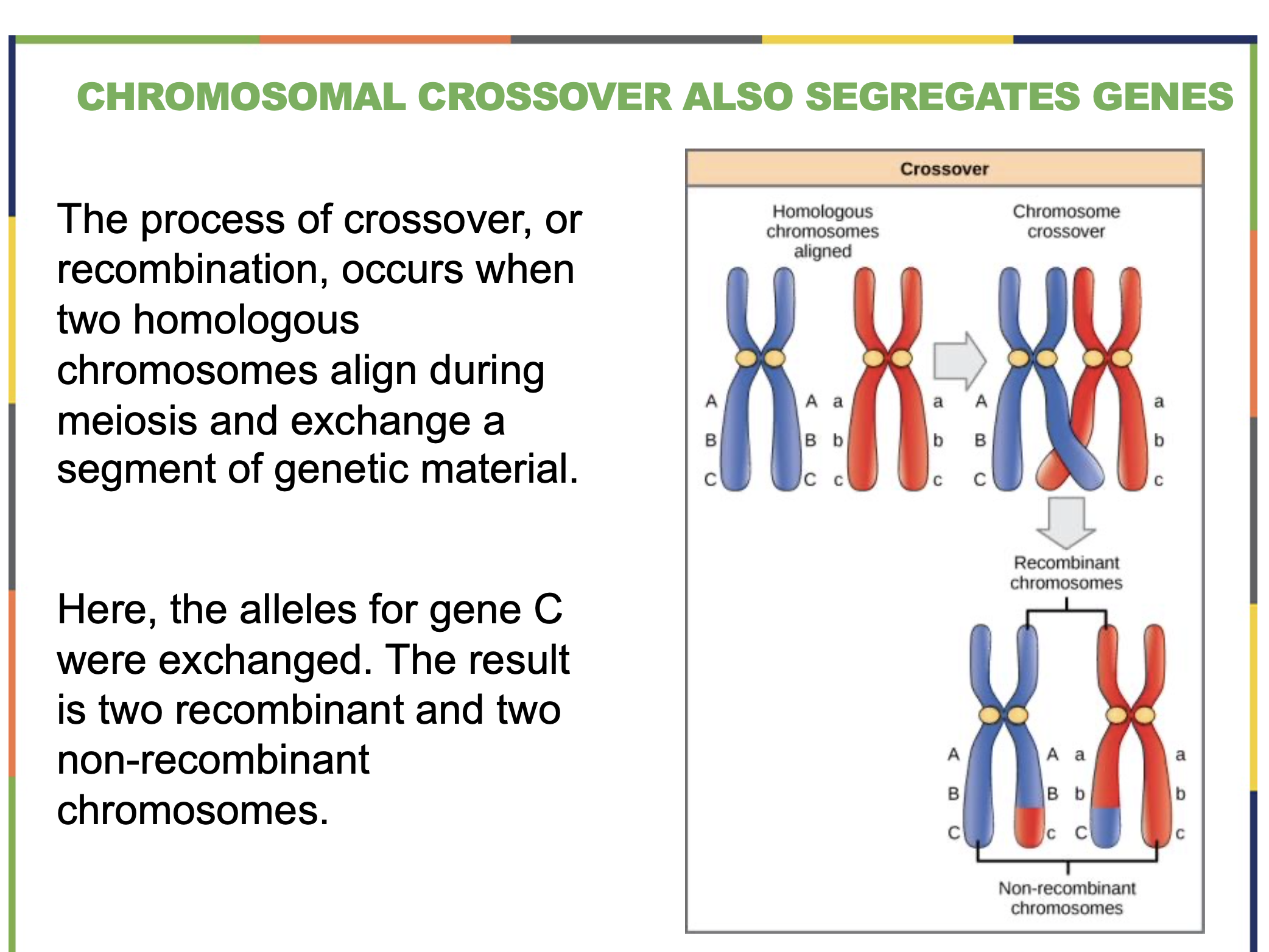
Mendel’s law of dominance
states that when an organism has two different alleles (heterozygote) for a trait, one allele (the dominant) can mask or hide the expression of the other allele (the recessive).
The dominant allele determines the organism’s appearance (phenotype) .
Each organism inherits two alleles for each gene — one from each parent.
If the two alleles are different (heterozygous):
The dominant allele is expressed (seen in the phenotype).
The recessive allele is hidden (its effect is not seen).
This explains why some traits “disappear” in one generation but “reappear” in the next (as seen in Mendel’s pea plants).
Mendel’s law of segregation
paired unit factors (i.e., genes) segregate equally into gametes such that offspring have an equal likelihood of inheriting any combination of factors
states that each organism has two alleles for every trait, and these alleles separate (segregate) during the formation of gametes (sperm and egg cells).
As a result, each gamete gets only one allele for each gene .
Every individual inherits two alleles for a gene — one from each parent.
During meiosis (the process that makes gametes), the two alleles separate, so each gamete carries just one allele.
When fertilization happens, two alleles (one from each parent) come together again in the offspring.
This process explains how traits can skip generations or reappear in later generations.
Mendel’s Experiment Example:
Trait: Seed color in pea plants
Y = yellow (dominant)
y = green (recessive)
Parent cross: Yy × Yy
When gametes form:
One gamete gets Y, the other gets y.
The offspring combinations can be:
YY, Yy, Yy, yy
Results:
3 yellow : 1 green ratio in offspring.
The green trait (recessive) reappears when both y alleles come together.
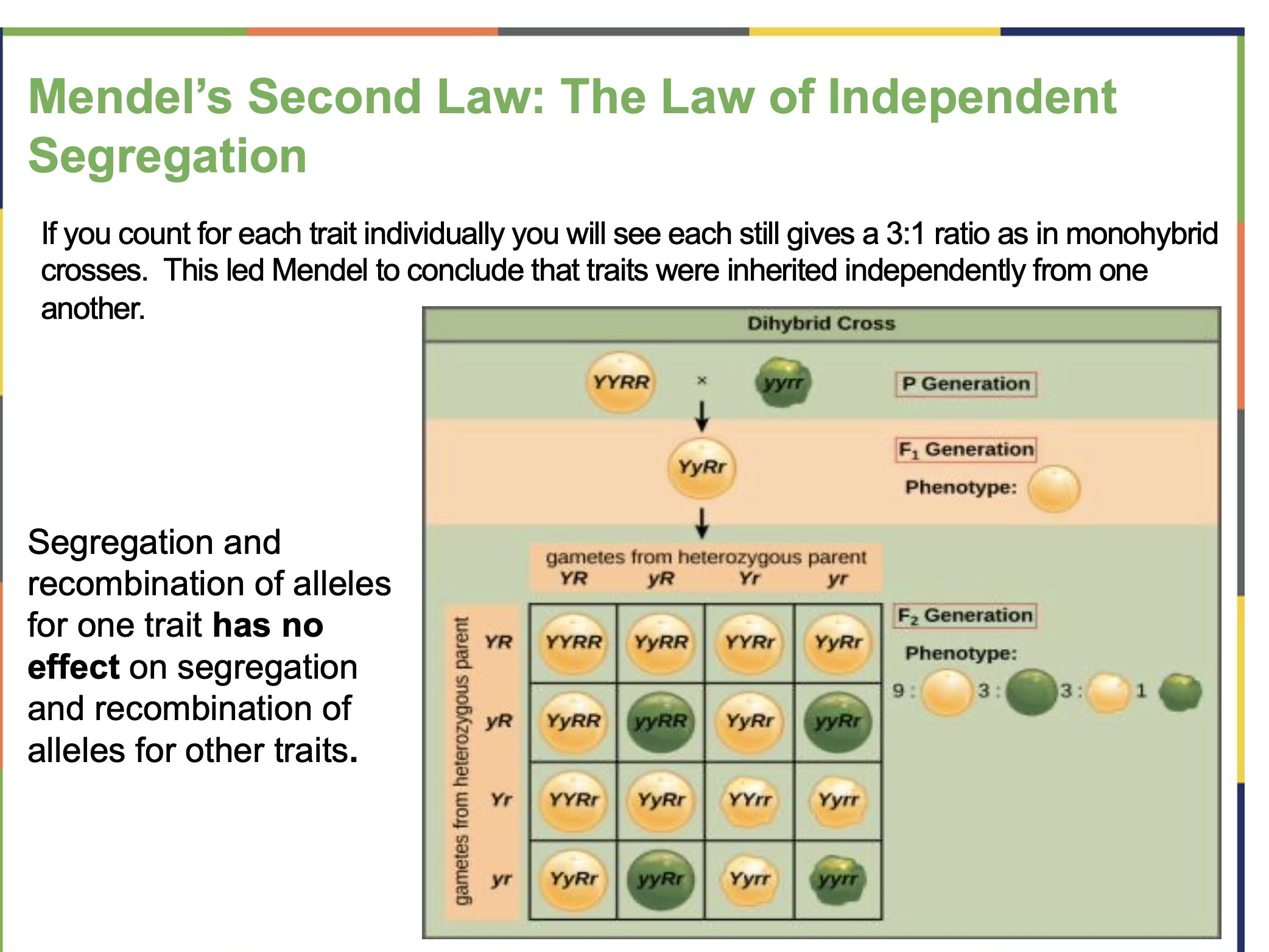
Mendel’s law of independent assortment
genes do not influence each other with regard to sorting of alleles into gametes; every possible combination of alleles is equally likely to occur
genes for different traits are inherited independently of one another — meaning the inheritance of one trait does not affect the inheritance of another trait.
This happens because alleles of different genes separate randomly during gamete formation (meiosis) .
Mendel’s Experiment Example (Dihybrid Cross):
Trait 1: Seed color – Yellow (Y) or Green (y)
Trait 2: Seed shape – Round (R) or Wrinkled (r)
Parent plants: YYRR × yyrr
→ All F₁ offspring: YyRr (yellow, round seeds)
When the F₁ plants (YyRr) were crossed, Mendel found the traits assorted independently, producing four types of gametes:
YR, Yr, yR, yr
Resulting offspring ratio (F₂):
9 yellow round
3 yellow wrinkled
3 green round
1 green wrinkled
→ 9:3:3:1 ratio
dihybrid cross
result of a cross between two true-breeding parents that express different traits for two characteristics
genetic cross between two individuals that are heterozygous for two different traits.
It’s used to study how two genes are inherited together and to show that each trait is passed on independently(following Mendel’s Law of Independent Assortment) .
helps predict how two traits appear in offspring at the same time.
It predicts how two genes are passed to offspring, creating a 9:3:3:1 pattern of traits.

Linkage
phenomenon in which alleles that are located in close proximity to each other on the same chromosome are more likely to be inherited together
If genes are on the same chromosome and close together, they tend to be inherited as a pair
Example:
Genes for red hair and freckles are often inherited together because they’re linked on the same chromosome.
Epistasis
when one gene affects or controls the expression of another gene.
one gene can “mask,” “block,” or change the effect of another gene on a trait .
Example 1 – Coat Color in Mice:
Gene 1 (C) – controls pigment production:
C = color
c = no color (albino)
Gene 2 (B) – controls pigment type:
B = black pigment
b = brown pigment
If a mouse has cc, it will be albino no matter what alleles it has at the B gene, because pigment can’t be made.
👉 The C gene is epistatic to B — it masks its effect.
Example 2 – Labrador Retrievers (Dogs):
Gene 1 (B) = black or brown pigment
Gene 2 (E) = controls whether pigment is deposited in fur
EE or Ee = color shows (black or brown)
ee = no pigment → yellow fur
If a dog has ee, the color gene (B) doesn’t matter — the dog will be yellow.
👉 The E gene is epistatic to B.
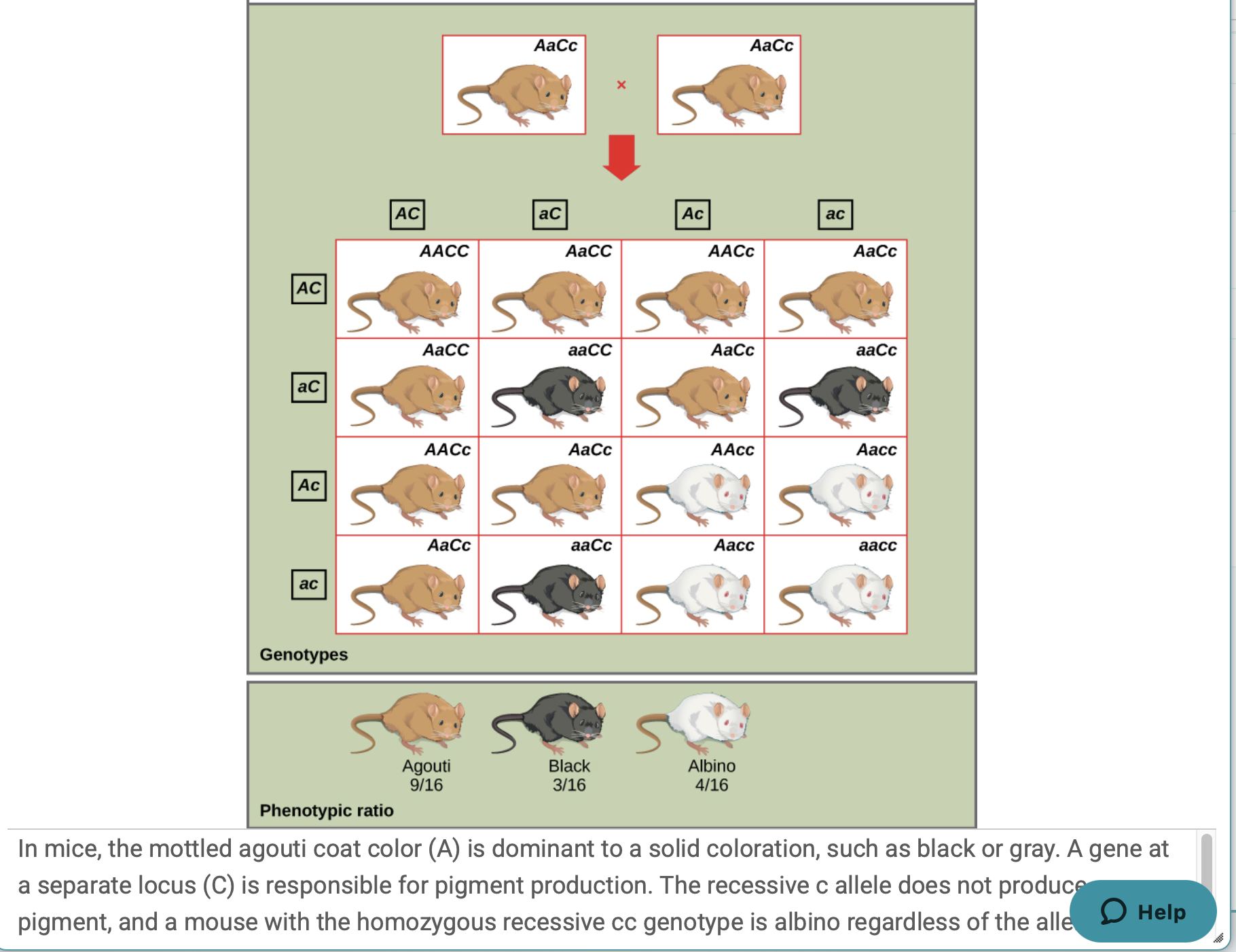
Probability Basics
Chance events are described by probability
Probability is given as a fraction or decimal equivalent over a range of zero to one. (also 0% to 100%)
A probability of 0 means an event will not happen and therefore is not due to chance at all.
A probability of 1 means an event will happen – it is certain and therefore not due to chance at all
Anything that is chance ranges between those value
For example, the chance of a flipped coin landing with heads up is ½ ( or 0.5, or 50%)
MULTIPLICATIVE LAW OF SIMPLE PROBABILITY
The overall chance for the occurrence of two or more independent random events in exact order is equal to the product of their individual probabilities.
is used to find the probability that two or more independent events will happen together (at the same time).
To find this, you multiply the probabilities of each individual event .
• For Example:
The chance of rolling exactly a five on a die is 1/6,
The chance of rolling exactly a four on a die is 1/6,
So, the overall chance of rolling exactly a five on the first die and then a four on the second die is :🇦
1/6 X 1/6 = 1/36
Simple Example (Coin Toss):
Probability of getting heads on one coin = ½
Probability of getting heads on a second coin = ½
Probability of both coins landing heads =
P(A and B)=½×½=¼P(A and B)=½×½=¼
➡ There’s a 25% chance both coins show heads.
Genetics Example (Mendelian Cross):
In a monohybrid cross (Yy × Yy), the probability of each parent giving a recessive allele (y) is ½.
So, the probability of offspring being yy (homozygous recessive) is:
P(y from mom)×P(y from dad)=½×½=¼P(y from mom)×P(y from dad)=½×½=¼
➡ 25% chance the offspring will show the recessive trait.
ADDITIVE LAW OF SIMPLE PROBABILITY
When there are multiple ways or tries for a chance outcome to occur, the overall probability is the sum of the individual events.
used to find the probability that one event OR another event will happen.
To find this, you add the probabilities of each event — and if the events can both happen at the same time, you subtract the overlap .
For Example:
If one can win by rolling a 4 or a 5 with one die, then the overall chance of winning is:
The chance of rolling a four is 1/6
Or the chance of rolling a five is also 1/6
So, the overall chance is 1/6 +1/6 = 2/6 = 1/3
Combining Multiplicative and Additive Law together
In many genetics or probability problems, you often have both “AND” and “OR” in the same situation.
When that happens, you simply apply both laws in order:
🔹 Use the Multiplicative Law first to find the probability of combined (independent) events.
🔹 Then use the Additive Law to find the total probability if either of those outcomes can occur.
What’s the probability of getting either two heads or two tails when tossing two coins?
Step 1: Use Multiplicative Law for each case (“and”)
Two heads (HH) = ½ × ½ = ¼
Two tails (TT) = ½ × ½ = ¼
Step 2: Use Additive Law (“or”)P(HH or TT)=¼+¼=½P(HH or TT)=¼+¼=½
✅ There’s a 50% chance of getting either two heads or two tails.
The chance of rolling a 5 and a 4 in any order is:
• Chance of a five first (1/6) times the chance of a 4 second (1/6) = 1/36
But, if order doesn’t matter we might also roll a four first (another 1/6) and a five second (another1/6) or, 1/36
• So, the overall chance is 1/36 + 1/36 = 2/36= 1/18.
How to Combine the Two
Use multiplication when events happen together → (“AND”).
Use addition when either event can occur → (“OR”).
Apply them in the same problem by working from the inside out —
Find probabilities of joint events (×) first,
Then combine them with either/or (+) logic.